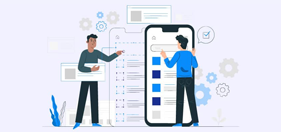Testing Best Practices to Follow in 2023
Apr 04, 2023 | 42Gears Team
Software testing is an integral part of the software development life cycle, as it helps in the identification and elimination of errors and bugs before an application is released. If you're new to testing and looking to learn how to perform tests to deliver high-quality applications/products, you've come to the right place. In this blog, we’re going to deep dive into the 5 testing best practices to follow in 2023.
1. Automation in Testing
Over the past few years, automation has become increasingly prevalent in testing, offering innumerable benefits such as swift feedback cycles, increased test coverage, script reusability, enhanced accuracy, and more. Frameworks like Selenium, Appium, and Cucumber help you increase test coverage. Codeless automation testing platforms are also gaining popularity, which is useful for teams without coding expertise. Katalon Studio, UiPath, and TestProject are a few codeless automation testing tools that you can use to employ automation testing.
2. Continuous Integration and Continuous Deployment (CI/CD) in Testing
CI/CD is a software development method that emphasizes frequent integration of code changes and automated testing to catch errors early on in the development phase and take applications/products to market faster. For the shift left method, CI/CD has become a significant aspect in the automation life cycle. Adding API and performance testing to CI/CD is also beneficial, as the cloud infrastructure automates the creation of multiple machines for stress and load testing.
3. Implementing a Continuous Monitoring Approach
Continuous monitoring is an automated process that enables the testing team to detect and observe errors throughout every stage of the testing life cycle. Ensuring that critical modules of an application are always functioning as intended is crucial, and application monitoring is the key ton achieving this goal. Automating critical use case testing ensures early detection and resolution of issues. Monitoring mechanisms promptly alert the team of any failures.
4. Effective Test Planning with Device Compatibility Testing
Selection of devices for testing is one of the most important aspects of ensuring that the app works across all device types, operating systems, and browsers. The best practices for selecting a device for testing are based on the intended audience, application use, region, screen size, resolution, and hardware for the newly developed application.
5. Documentation
Regardless of whether CI/CD is in place or if the product is being tested manually, it is crucial to document the testing process, test plan, test cases, and test results. It’s also better to have an automation mechanism that is capable of capturing network logs, device logs, and screenshots that are associated with the corresponding test cases. This documentation can serve as a record of the testing that has been completed and can be used for analyzing and identifying the root cause of the test failure.
Put these best practices to use with AstroFarm by 42Gears
Use AstroFarm by 42Gears, a private device farm solution, to streamline your testing process.
1. Employ Automation Testing by remotely scaling up your tests on devices integrated with frameworks such as Appium and Selenium.
2. For CI/CD purposes, AstroFarm provides Rest APIs that can dynamically procure devices and start running test cases if a pipeline is already defined in Jenkins.
3. Leverage Device Compatibility Testing by monitoring CPU and Memory utilization, as well as each device's processes in real-time during testing sessions.
4. Retrieve the logs of connected devices from the console for troubleshooting and analytics, which can be helpful in documentation.
As testing trends evolve and fade, don’t forget the ultimate goal of testing—to deliver the best possible functional and user-friendly application.
Employ best testing practices with
AstroFarm today!
Subscribe for our free newsletter


